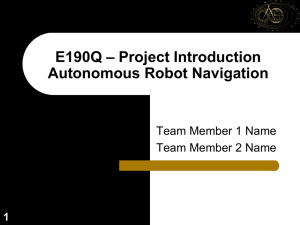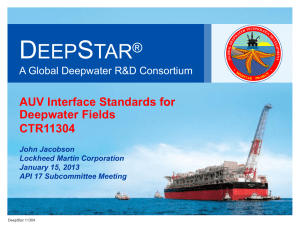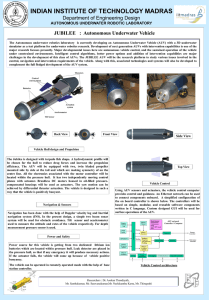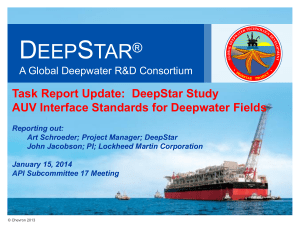AS2014_AUV_AAR
advertisement
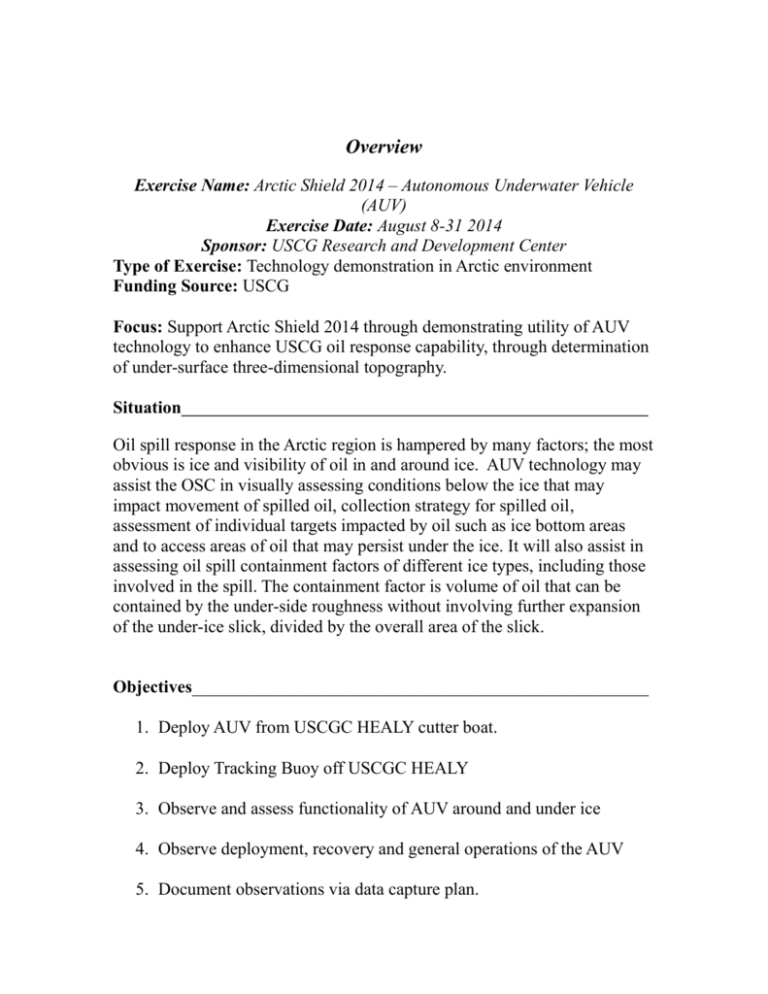
Overview Exercise Name: Arctic Shield 2014 – Autonomous Underwater Vehicle (AUV) Exercise Date: August 8-31 2014 Sponsor: USCG Research and Development Center Type of Exercise: Technology demonstration in Arctic environment Funding Source: USCG Focus: Support Arctic Shield 2014 through demonstrating utility of AUV technology to enhance USCG oil response capability, through determination of under-surface three-dimensional topography. Situation______________________________________________________________ Oil spill response in the Arctic region is hampered by many factors; the most obvious is ice and visibility of oil in and around ice. AUV technology may assist the OSC in visually assessing conditions below the ice that may impact movement of spilled oil, collection strategy for spilled oil, assessment of individual targets impacted by oil such as ice bottom areas and to access areas of oil that may persist under the ice. It will also assist in assessing oil spill containment factors of different ice types, including those involved in the spill. The containment factor is volume of oil that can be contained by the under-side roughness without involving further expansion of the under-ice slick, divided by the overall area of the slick. Objectives____________________________________________________ 1. Deploy AUV from USCGC HEALY cutter boat. 2. Deploy Tracking Buoy off USCGC HEALY 3. Observe and assess functionality of AUV around and under ice 4. Observe deployment, recovery and general operations of the AUV 5. Document observations via data capture plan. Participating Organizations____________________________________________________ HEALY. USCG Research and Development Center (RDC). University of Cambridge, with Funding from the European Commission ACCESS project. Planning Team___________________________________________________________________ LCDR William Woityra - Operations Officer - CGC HEALY Rich Hansen – Chief Scientist – RDC Peter Wadhams – Lead researcher – Cambridge University Richard Yeo – AUV operator – Cambridge University Scot T. Tripp – AUV Lead - RDC Operations____________________________________________________ 05 Aug 2014 – RDC advanced logistics support team arrived in Anchorage and provided the AUV shipper Power of Attorney to allow the AUV to clear customs. The team then travel to Seward to on-load all gear to HEALY that was shipped after HEALY departed Seattle. 06 Aug 2014 – Gavia was deployed from the beach at Seward by the Cambridge team. All AUV gear was then loaded onto HEALY. Cambridge team Boarded HEALY in Seward and began their unpacking and equipment checks. Cambridge team was working to have the AUV ready to splash in Nome. 13 Aug 2014 – A trial run with the Gavia AUV was conducted. The Cambridge team deployed the Gavia while anchored off Nome. The Gavia was lowered from the starboard a-frame to the Cutter Boat Large (CBL). Because they are running the Gavia upside down to capture under ice features, the AUV must be physically held right side up along the CBL in order to establish communications and start the unit. The tracking buoy was deployed off the port side. Due to difficulty stabilizing the Navigation system, Gavia and the CBL drifted 2 miles astern of HEALY, out of range of tracking buoy. AUV runs were attempted but the unit aborted, likely due to currents and inability to maintain GPS locations. 14 Aug 2014 – The Arctic Survey Boat (ASB) picked up the last of the new passengers and headed north to the Arctic ice fields. 16 Aug 2014 – The HEALY arrived in the Arctic ice fields and the 48 hour oil tracking exercise was started. Winds preclude deployment of Dye and oranges and grounded the Puma and the aerostat. The AUV was deployed Page 2 of 6 at 1400. The CBL took them to a ridged ice flow. The Operator could not get the AUV to move the propeller. Mission aborted and team returned to HEALY. Diagnostics commenced. Loose connections were found inside the AUV. Connections were tightened and the AUV was reassembled for possible ops on the 17th. 17 Aug 2014 –High winds continued into the second day so the 48 hour oil tracking exercise was postponed. The AUV was given clearance to deploy at 1330. The AUV team was deployed on the CBL, the tracking buoy was then deployed and the system was ready to go at 1400. The AUV failed to initiate the spinning of its propellers. The operator initiated a restart of the AUV (45 minutes) and re-deployed. It was very awkward to hold AUV inverted to establish communications as there were sizable waves but the unit started up and headed out. The tether line immediately got tangled and the AUV aborted the mission. (the operator indicated that there was a possibility that the AUV may have aborted prior to the tangle). The AUV was brought back on board the boat, the operator conducted a quick reset, and the AUV was redeployed, the Unit started and two man team began paying out the tether. The AUV stops (aborts) and is recovered. Another quick reset is initiated and the AUV is redeployed. The unit starts but the tether gets tangled again, The AUV aborts, (may have already aborted). The AUV is recovered and the CBL returned to the HEALY. The Software is investigated and a possible code problem is corrected. The operator reprogrammed the AUV and remade the tether payout into a bucket rather than on a wheel. The Cambridge team is ready for ops on Monday the 18th. 18 Aug 2014 – The AUV is deployed from the ASB in the afternoon. The team deployed close to the HEALY. A successful mapping of a ridged floe close to ship was accomplished, with successful tracking by the transponder. The ASB was then ordered back to the ship precluding further surveys that day. 19 Aug 2014 – The AUV is deployed from the CBL in the morning and the afternoon. Mapping of a heavily ridged floe was accomplished in the morning at considerable distance from ship. The Puma flew over the ridge that was mapped from below. In the afternoon the AUV mapped a ridged floe closer to the ship. The tracker worked in the afternoon but not the morning due to long range. 20 Aug 2014 – No operations were conducted on this day. The morning was set aside for mapping under an ONR buoy if found. The HEALY spent the morning in search of the ONR buoy. The buoy was located around noon on a small piece of ice lying on its side. The decision was made to photo the site and then steam south to investigate DARPA buoys. The ice with the Page 3 of 6 ONR buoy on it was considered too small to map and the buoy will likely melt off in a day or two. The contextual thickness distribution of the floes around the buoy would have been of value scientifically for understanding the buoy motion and the ice decay rate since they were probably part of a single floe containing the buoy, This could have been better determined with an additional under ice survey, however, operational constraints required departure from the area. Also the decision was made not to re-launch ASB to straighten the buoy. As a result, performance of the buoy in transmitting wave data will be compromised for a short time until the floe is fully melted and the buoy floats in water Lessons Learned_______________________________________________ 1. Need to thoroughly review launch, retrieval, and operations options in advance. Upside down AUV with tether required water level handling (i.e. boat launch) and dedicated boat time which resulted in schedule conflicts with the other science teams requiring boat support. This was further complicated because there were only two qualified coxswains aboard the ship. As a result many opportunities to obtain AUV runs using the CBL were lost. Additional under ice maps, beyond the three that were recorded, could have been obtained without adding dedicated ship time. Other options such as a deck launched quick release cradle would have also allowed more opportunities for AUV operations. 2. Need to insure a better understanding of auxiliary gear between RDC and science team. When science team says they need to have a tracking buoy on a line, they may mean a 10 foot aluminum pole with a hydrophone on the base, an inflatable buoy in the middle and a GPS antenna on the top that needs to be weighted down and requires a team to launch. Meanwhile the planners are thinking a buoy with a hydrophone hanging from a rope that is lowered over the side by one person. 3. Need to manage expectations of science teams with regards to Coast Guard procedures and policy. Science team for the AUV was comfortable with seeing an ice floe that looks pretty big and being able to go out on it, based on their experience. Coast Guard policy precludes that kind of activity and insists on conducting full ice recon prior to allowing ‘on ice’ operations. 4. An email outlining some of the constraints of shipboard operations should be sent out well in advance of the cruise. Specifically that there will be time that opportunities for operations will be missed due to conflicts with other technologies being deployed, or due to ships requirements and training Page 4 of 6 obligations. This has been an issue between the Coast Guard and the National Science Foundation for some time. Both sides are right but it is important when the RDC is bringing a science team aboard the HEALY at no ship cost to them, that they understand what the ship decides is the way it will go. No questions, no debate. The ships command will have been briefed of the requirements of all parties and will make the final decision. 5. As an add on to #4, it is very important the each science team clearly states their requirements, primary goals and other ‘would like to accomplish’ activities ahead of time. To add on requirements and activities as we are sailing to the ice will likely result in them not happening. Conclusion____________________________________________________ 1. This particular AUV and how it was operated could have been better prepared for this mission. Due to insurance concerns, the leased AUV had to be tethered which hampered operations by adding another point of failure. The complications of running the unit upside down to use bottom looking sonar to image under ice structure put another operational complication into the launch sequence. It was very hard for the launch crew to maintain the AUV right side up while communications were established prior to release. 2. This particular unit was much easier to handle than the AUV used last year in that it was man portable. 3. The imagery from the AUV was good when the unit ran well. The top side topography was not taken due to weather and Coast Guard procedural issues precluding take off of the quad-copter from the flight deck.. Recommended Future Actions___________________________________ 1. The most critical recommendation is to manage science team expectations and encourage them to consider multiple modes of operation. Up front, let them know that there will be fog, there will be Page 5 of 6 high winds, there are restrictions on what ice you can get on, and there are competing requirements for limited resources. 2. AUV’s may be a good option to map under ice entrained oil but there needs to be some real capability tested. The right sensor package that would actually be used in an incident would be preferred. We have not yet demonstrated a unit that can do the job completely yet. This would include launching, having the AUV conduct a search, messaging to the ship if oil is detected, mapping the extent of the find and returning to the ship without a tether. Recommend that the next AUV ops consider that as the challenge. The RDC may want to undertake this one with their own AUV. Page 6 of 6
